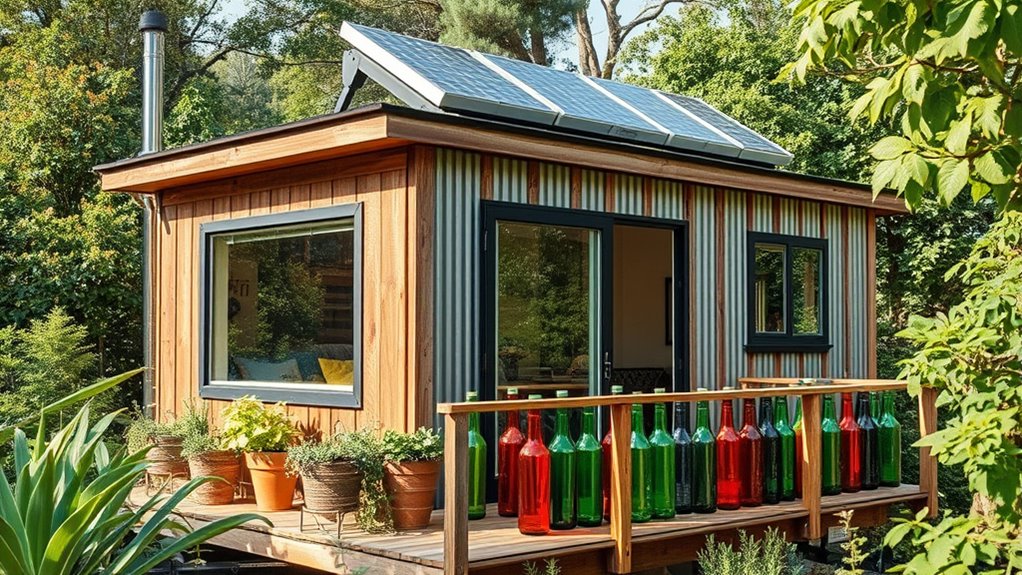Using recycled materials is a smart way to design an eco-friendly tiny home that’s cost-effective and full of character. You can upcycle furniture, like wooden pallets or vintage suitcases, to add charm while reducing waste. Incorporate solar-powered appliances and use salvaged building materials to maximize sustainability. This approach not only lowers your environmental impact but also creates a unique, cozy space. Keep exploring to discover creative ideas that make tiny living truly green and personalized.
Key Takeaways
- Incorporate reclaimed wood for furniture and structural elements to reduce waste and add character.
- Use recycled metal, glass, and plastic for fixtures, decor, and storage solutions to promote eco-friendly living.
- Upcycle old items like suitcases or pallets into functional furniture, enhancing space and sustainability.
- Source materials from salvage yards or second-hand stores to minimize environmental impact and support circular economy.
- Install solar-powered appliances using recycled components to generate renewable energy and decrease reliance on non-renewable resources.

Living sustainably in a tiny home becomes even more achievable when you incorporate recycled materials into your design. This approach not only reduces waste but also adds character and uniqueness to your space. One of the most effective ways to do this is through upcycling furniture. Instead of buying new pieces, you can breathe new life into old furniture by sanding, repainting, or repurposing it. For example, an old wooden pallet can become a coffee table, or vintage suitcases can serve as storage trunks. These projects save money, divert items from landfills, and give your tiny home a personalized touch. Plus, upcycled furniture often has a charm that mass-produced items lack, making your space feel warmer and more inviting.
In addition to furniture, choosing solar-powered appliances complements your eco-friendly mindset. Solar technology has advanced considerably, making it more accessible and efficient for tiny homes. Installing solar panels on your roof allows you to generate your own electricity, reducing reliance on the grid and lowering energy bills. With solar-powered lights, refrigerators, and water heaters, you’re maximizing renewable energy use and minimizing your carbon footprint. These appliances are designed to be energy-efficient, making them perfect for small spaces where every watt counts. Integrating solar power into your tiny home isn’t just an environmentally conscious choice; it’s also a practical one that offers independence and resilience, especially during power outages or in remote locations.
Living sustainably in a tiny home hinges on thoughtful, intentional choices. Recycled materials play an essential role in this, from upcycled furniture that adds vintage charm to solar-powered appliances that keep your energy consumption in check. You can find inspiration in second-hand shops, salvage yards, or online marketplaces focused on sustainable products. Don’t shy away from DIY projects—many upcycling ideas are simple and rewarding. When you combine these efforts, you create a space that’s not only cost-effective but also low-impact on the environment. Every element, from repurposed furniture to solar tech, reinforces your commitment to a greener lifestyle while making your tiny home a cozy, functional sanctuary.
Frequently Asked Questions
Are Recycled Materials Safe for Indoor Air Quality?
Recycled materials can be safe for indoor air safety if they undergo proper recycled material testing. You should always verify that the materials meet safety standards and are free from harmful chemicals or emissions. Look for products certified by trusted organizations, and ask suppliers about their testing procedures. When you choose well-tested recycled materials, you can enjoy eco-friendly, sustainable tiny living without compromising indoor air quality.
How Do Recycled Materials Affect Building Codes and Permits?
Recycled materials can impact building code compliance and permit approval processes since regulations vary by location. You’ll need to verify these materials meet safety standards, fire codes, and structural requirements. Sometimes, you may need to provide documentation or testing results to demonstrate compliance. It’s vital to consult local building authorities early, so you can address any specific restrictions or approvals needed for using recycled materials in your tiny home project.
Can Recycled Materials Provide Adequate Insulation and Durability?
Recycled materials can provide adequate insulation performance and durability if you select the right types. For example, recycled denim or cellulose offer good insulation, while reclaimed wood and metal can guarantee material longevity. You need to evaluate each material’s properties and proper installation to meet your climate and safety standards. When chosen carefully, recycled materials can create a sustainable, durable tiny home that performs well over time.
What Are Cost Comparisons Between Recycled and New Building Materials?
Recycled materials often cost less than new building supplies, leading to significant cost savings for your tiny home project. You’ll also enjoy environmental benefits, as reusing materials reduces waste and minimizes resource extraction. While initial expenses may vary based on availability, overall, recycled options tend to be more affordable and eco-friendly, helping you create a sustainable tiny living space that’s budget-conscious and environmentally responsible.
How to Source Reliable Recycled Materials Locally?
Did you know that over 60% of recycled materials are sourced locally? To find reliable recycled materials, focus on eco-friendly sourcing by visiting local recycling centers and salvage yards. These places often have quality materials like wood, metal, and glass suitable for tiny living projects. Connect with community groups or online local marketplaces too, ensuring you get trustworthy supplies while supporting your area’s recycling efforts.
Conclusion
Embracing recycled materials in tiny living is like planting a seed that grows into a sustainable future. Just like Sarah transformed her cluttered garage into a cozy, eco-friendly home with reclaimed wood and old windows, you can turn everyday waste into a beautiful, functional space. Every recycled item you use reduces landfill waste by about 600 pounds annually per household. Your small steps today can create a greener tomorrow—proving that tiny living truly makes a big impact.







